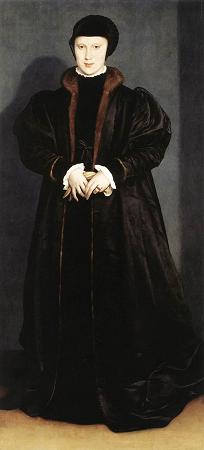Christina of Denmark (1521 - 1590). Christina of Denmark was a Danish princess, the younger surviving daughter of King Christian II of Denmark and Norway and Isabella of Austria. She became the duchess-consort of Milan, then duchess-consort of Lorraine. Sebastian Bourdon's portrait of Christina shows her in three-quarter view, looking directly at the viewer. She is dressed in rich, dark clothing, indicative of her status, and wears a pearl necklace and a feather in her hat. The portrait is known for its realism and dignity. She appears in Carl Gustaf Hellqvist's Queen Christina's Abdication, where she is shown in relation to symbols of power and authority. She served as the regent of Lorraine from 1545 to 1552 during the minority of her son. She was also a claimant to the thrones of Denmark, Norway and Sweden in 1561-1590. Finally, she was sovereign Lady of Tortona in 1578-1584. Christina was born in Nyborg in central Denmark in 1521. In January 1523, nobles rebelled against her father and offered the throne to his uncle, Duke Frederick of Holstein. Christina and her sister and brother followed their parents into exile in April of the same year, to Veere in Zeeland, the Netherlands, and were raised by the Dutch regents, their grandaunt and aunt, Margaret of Austria and Mary of Hungary. Her mother died on 19 January 1526. In 1532, her father Christian II of Denmark was imprisoned in Denmark after an attempt to retake his throne. The same year, her brother died, and she became second in line to her father's claim to the Danish throne after her elder sister Dorothea. Christina was given a good education by her aunt, the regent of the Netherlands, under supervision of her governess, Madame de Fiennes. She was described as a great beauty, intelligent and lively, and enjoyed hunting and riding. As a ward of her uncle the Emperor, Charles V, Holy Roman Emperor, and a member of the Imperial house, she was a valuable pawn on the political marriage market. In 1527, Thomas Wolsey, Primate of England, suggested that the illegitimate son of Henry VIII be married to Christina or Dorothea, but the Habsburgs did not wish for them to marry someone born out of wedlock. In 1531, Francesco II Sforza, Duke of Milan proposed to marry either of the sisters, as he wished to make an alliance to the Imperial house. Charles V denied him a match with Dorothea, but agreed to a marriage with Christina. On 23 September 1533 in Brussels, Christina was married by proxy to Francesco II Sforza, Duke of Milan, through his representative Count Massimiliano Stampa. On 3 May 1534, Christina made her official entry in Milan among great festivities, and on 4 May, the second wedding ceremony was celebrated in the hall of the Rocchetta. Christina's relationship with Francesco was reportedly good, and she was very popular in Milan, where she was regarded as a symbol of peace and hope for the future after decades of war, and her beauty was much admired. She enjoyed hunting parties, and the palace was redecorated and beautified for her. When she was given her own court, her chief lady in waiting was Francesca Paleologa of Montferrat, spouse of Constantine Comnenus, titular Prince of Macedonia, who was to become one of her most intimate lifelong friends. Francesco II Sforza was at that time very weak, as his health had never recovered after he survived a poison attempt years before, and there was concern that he would never be able to have children, and die without heirs. According to the marriage settlement, the Duchy of Milan was to become a part of the Empire if it did not result in issue. She and Francesco had no children. Francesco II Sforza died in October 1535, leaving her widowed when she was thirteen. Her rights as a widow to the town of Tortona for life was secured, while the Duchy was incorporated with the Empire. However, Massimiliano Stampa remained in charge as castellan of Milan, and Christina remained in the ducal residence.
more...



